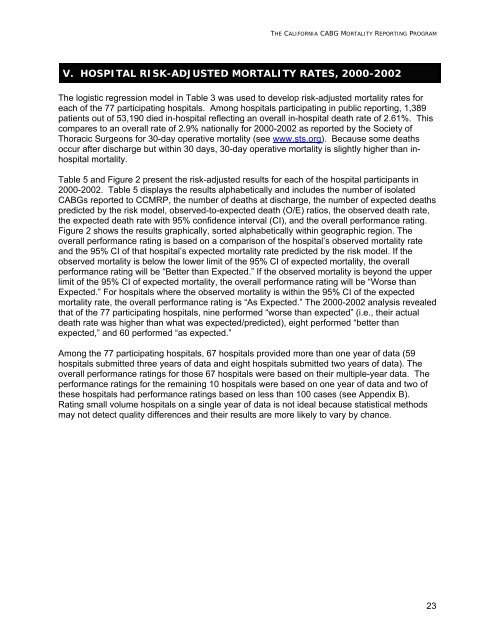The California Report on Coronary Artery Bypass Graft Surgery
The California Report on Coronary Artery Bypass Graft Surgery
The California Report on Coronary Artery Bypass Graft Surgery
- No tags were found...
You also want an ePaper? Increase the reach of your titles
YUMPU automatically turns print PDFs into web optimized ePapers that Google loves.
THE CALIFORNIA CABG MORTALITY REPORTING PROGRAMV. HOSPITAL RISK-ADJUSTED MORTALITY RATES, 2000-2002<str<strong>on</strong>g>The</str<strong>on</strong>g> logistic regressi<strong>on</strong> model in Table 3 was used to develop risk-adjusted mortality rates foreach of the 77 participating hospitals. Am<strong>on</strong>g hospitals participating in public reporting, 1,389patients out of 53,190 died in-hospital reflecting an overall in-hospital death rate of 2.61%. Thiscompares to an overall rate of 2.9% nati<strong>on</strong>ally for 2000-2002 as reported by the Society ofThoracic Surge<strong>on</strong>s for 30-day operative mortality (see www.sts.org). Because some deathsoccur after discharge but within 30 days, 30-day operative mortality is slightly higher than inhospitalmortality.Table 5 and Figure 2 present the risk-adjusted results for each of the hospital participants in2000-2002. Table 5 displays the results alphabetically and includes the number of isolatedCABGs reported to CCMRP, the number of deaths at discharge, the number of expected deathspredicted by the risk model, observed-to-expected death (O/E) ratios, the observed death rate,the expected death rate with 95% c<strong>on</strong>fidence interval (CI), and the overall performance rating.Figure 2 shows the results graphically, sorted alphabetically within geographic regi<strong>on</strong>. <str<strong>on</strong>g>The</str<strong>on</strong>g>overall performance rating is based <strong>on</strong> a comparis<strong>on</strong> of the hospital’s observed mortality rateand the 95% CI of that hospital’s expected mortality rate predicted by the risk model. If theobserved mortality is below the lower limit of the 95% CI of expected mortality, the overallperformance rating will be “Better than Expected.” If the observed mortality is bey<strong>on</strong>d the upperlimit of the 95% CI of expected mortality, the overall performance rating will be “Worse thanExpected.” For hospitals where the observed mortality is within the 95% CI of the expectedmortality rate, the overall performance rating is “As Expected.” <str<strong>on</strong>g>The</str<strong>on</strong>g> 2000-2002 analysis revealedthat of the 77 participating hospitals, nine performed “worse than expected” (i.e., their actualdeath rate was higher than what was expected/predicted), eight performed “better thanexpected,” and 60 performed “as expected.”Am<strong>on</strong>g the 77 participating hospitals, 67 hospitals provided more than <strong>on</strong>e year of data (59hospitals submitted three years of data and eight hospitals submitted two years of data). <str<strong>on</strong>g>The</str<strong>on</strong>g>overall performance ratings for those 67 hospitals were based <strong>on</strong> their multiple-year data. <str<strong>on</strong>g>The</str<strong>on</strong>g>performance ratings for the remaining 10 hospitals were based <strong>on</strong> <strong>on</strong>e year of data and two ofthese hospitals had performance ratings based <strong>on</strong> less than 100 cases (see Appendix B).Rating small volume hospitals <strong>on</strong> a single year of data is not ideal because statistical methodsmay not detect quality differences and their results are more likely to vary by chance.23



